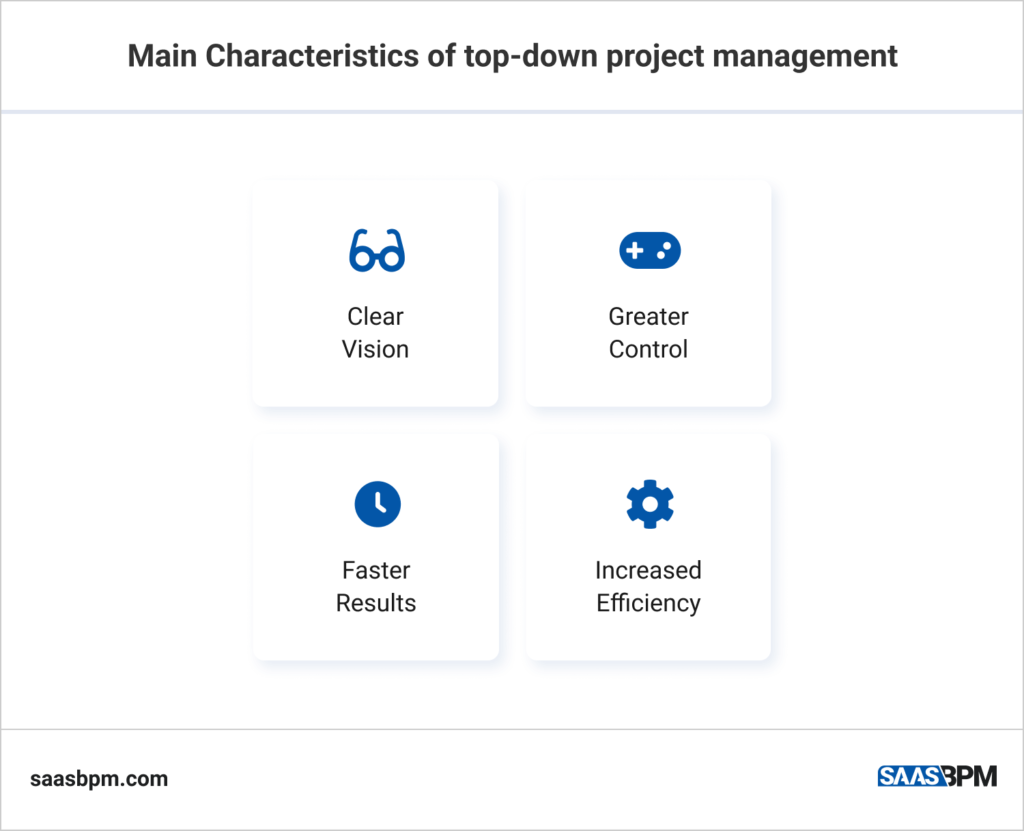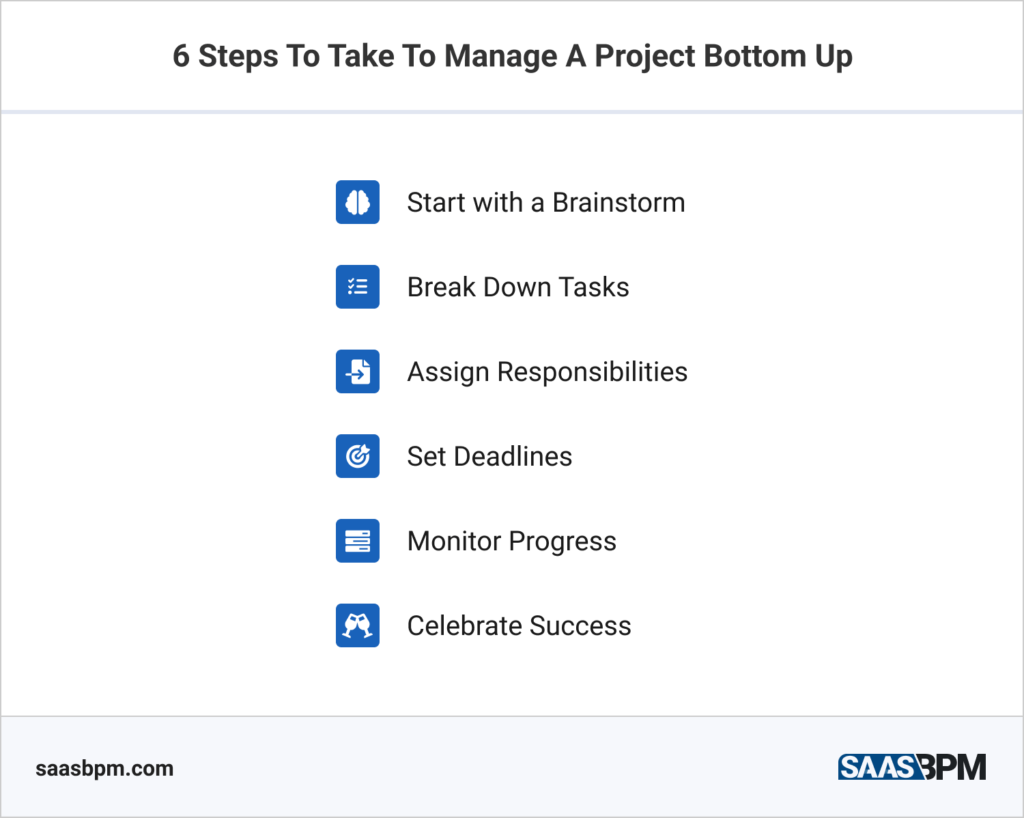Project management is a long process that requires careful, consistent planning. In fact, the ability of a leader to effectively plan and control the steps necessary to achieve their objectives is essential for success. One important question when managing your business processes is what type of approach should be taken: bottom-up, or top-down?
It is important to determine the model you are going to use early on, preferably before your team has started executing the project. This is so that you avoid drastic shifts of priorities that may lead to confusion, and motivation and productivity decrease. As of 2022, 39% of projects fail because of changes in organization priorities.
In this article, we will explore both approaches, their pros and cons, and share tips to decide which is best for your organization. Let’s go!
Defining Top-Down & Bottom-Up Project Management

The top-down approach involves setting goals at the highest level of the project management strategy. This requires that objectives be identified and then broken down into smaller tasks. This approach can be beneficial in cases where the project manager has a clear vision of what needs to be accomplished and wants to ensure that all team members are working towards the same goals.
The bottom-up approach involves starting off with small, manageable tasks that all contribute to one big goal. This allows the project manager to gain a better understanding of the project’s scope, and to delegate responsibilities accordingly. In many cases, this approach is preferred as it allows for greater input from team members and better collaboration.
Both bottom-up and top-down approaches have their strengths and weaknesses. The right approach for any given project will depend on the specific goals, the project manager’s vision, and the resources available.
Top-Down Project Management: Pros & Cons
As we mentioned above, the top-down project management methodology involves setting objectives at the highest level and then breaking them down into smaller tasks. This allows for a more efficient distribution of resources, as well as greater control over the project’s progress.
Main Characteristics of top-down project management

– Clear Vision: The project manager has a clear goal in mind and can easily communicate it to the team.
– Greater Control: With a top-down approach, the project manager is able to keep tight control over the progress and delegate tasks accordingly.
– Faster Results: By focusing on the most important tasks first, your team will achieve results faster.
– Increased Efficiency: With a top-down approach, the project manager can quickly identify areas where resources are being used inefficiently and make changes accordingly.
The primary advantage of this structure is that it enables leaders to have full visibility over all aspects of their projects, allowing them to make quick decisions and stay on top of progress.
However, the top-down approach has some potential drawbacks as well. It can be difficult for team members to feel empowered when tasks are assigned from the highest level, and it can lead to a lack of collaboration between departments or project teams. In addition, the lack of flexibility in this approach can make it difficult to respond quickly to changes or problems that may arise during the project.
6 Steps To Take To Manage A Project Top Down
Anyone who’s ever been in charge of a project knows that there’s a lot more to it than just organizing and coordinating tasks. In order to be successful in top-down management, you need to have a clear vision for the “big picture” and a plan for how to achieve it. Here are 6 steps that will help you manage your project top down.

1. Establish Your Goals: Establishing clear and measurable goals for your project is the first step in project management.
2. Set Responsibilities: Assigning tasks to team members is key to ensuring that everyone knows what their role is in the project.
3. Monitor Progress: Regularly monitoring progress will help you keep track of how close you are to achieving your project goals.
4. Stay Organized: Staying organized throughout the life of the project will help ensure that tasks are completed on time and resources are used efficiently.
5. Analyze Results: Once the project ends, analyze the results and make adjustments for future projects.
6. Celebrate Success: Celebrating the success of your project is important to ensure that everyone feels motivation and excitement about future projects.
By taking these steps, you can ensure that your top-down approach is successful and that you are able to achieve your project goals in an efficient and effective manner.
Bottom-Up Project Management: Pros & Cons
The bottom-up approach focuses on small, manageable tasks that contribute to one big goal. This process starts with the team and allows for more input from individual members, as well as greater collaboration between departments.
Main Characteristics of bottom-up project management
– More Input: Team members are invited to contribute ideas and take ownership of tasks.
– Greater Collaboration: With everyone working towards a common goal, collaboration between departments is better.
– Flexibility: The team can quickly respond to changes or problems that arise.
– Increased Buy-In: Team members feel more invested in the project and its success.
The primary advantage of this approach is that it allows team members to feel empowered and provides greater flexibility if changes or issues arise during the course of a project. Additionally, by inviting input from all team members, collaboration increases which can lead to more successful outcomes.
However, the bottom-up method can also have some disadvantages. It can be difficult for team members to keep track of all of the tasks and progress, leading to confusion and inefficiency. Furthermore, it can be hard to communicate a clear goal from the top if you didn’t establish the vision clearly at the beginning of the project.
6 Steps To Take To Manage A Project Bottom Up
In order to manage your project this way, you need to be very patient and attentive to details. Also, because you and your team would be dwelling on smaller tasks and targets working their way up, you need to also have a good understanding of how each assignment correlates with the rest.
Here are 6 steps to manage your project from the bottom up like a pro:

1. Start with a Brainstorm: Invite your team to share ideas and provide input on the project goals.
2. Break Down Tasks: Create small, manageable tasks that contribute to the overall goal of the project.
3. Assign Responsibilities: Assign tasks to individual team members or departments based on their expertise and availability.
4. Set Deadlines: Establish deadlines for each task.iscuss the timeline with team members to ensure that everyone is on the same page.
5. Monitor Progress: Make sure that tasks are completed on time and that resources are being used efficiently.
6. Celebrate Success: Give recognition to team members for a job well done and celebrate when the project is completed.
By taking these steps, you can ensure that your bottom-up approach is successful and that everyone feels invested in the final outcome.
Deciding Which Approach Is Right for Your Project
Ultimately, the decision of which approach is best for your project will depend on the specific goals and resources available. If you have a clear vision and need to meet tight deadlines, a top-down approach may be best for you.
On the other hand, if you need to involve many stakeholders and require flexibility in your project, then a bottom-up approach may be most suitable for your needs.
The top-down project management model is more appropriate when projects have a clear goal and timeline. On the contrary, the bottom-up approach is a better fit for projects that require collaboration and creativity. By understanding both approaches and their features, you can make an informed decision as to which will best suit your needs. In either case, having a strong team and good communication are key elements of success.
Final Thoughts
In conclusion, it is important to understand the difference between top-down and bottom-up project management approaches. This is so you can make an informed decision about what’s best for you. These two methods are both excellent in certain situations. However, they each have pros and cons to consider before deciding which one to use for your project. If you take the time to thoughtfully consider which approach will work better for you, you increase the chances of success for your project–whatever type of project it may be.

